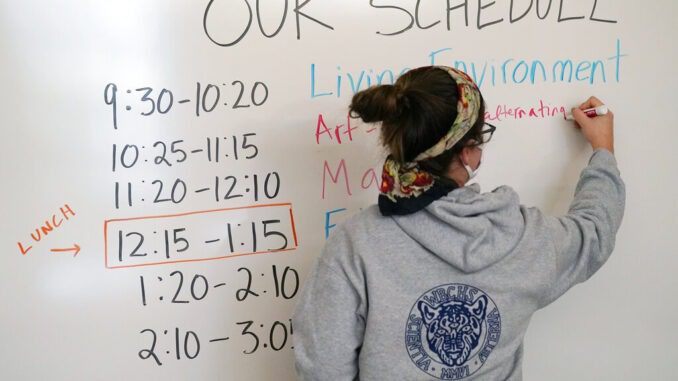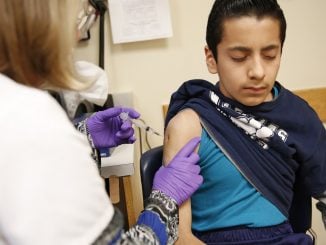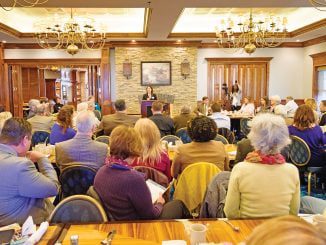
RALEIGH — The N.C. State Board of Education heard COVID-19 updates from officials from N.C. Department of Health and Human Services last week, which included they’ve found no evidence that public school reopenings have contributed to the state’s recent rise in positive cases.
N.C. Department of Health and Human Services (NCDHHS) Chief Deputy Secretary Susan Gale Perry opened up the presentation on the status of state’s K-12 public school reopenings. Joining Perry was Dr. Elizabeth Cuervo Tilson, State Health Director and Chief Medical Officer, and Rebecca Planchard, Senior Policy Advisor.
Tilson lead the remarks for the team and said that although positive tests in North Carolina have been rising, “we are not seeing schools as a big driver of cases.” She also said that children “have relatively low rates of infection and are not driving our increases.”
While discussing a chart of new positive cases by age group, Tilson noted that in education age ranges, college students are the ones “driving infection rates.”
The CDC, as well as national and state-level health officials, have said that children – especially young children – are less likely to spread COVID-19. Tilson said that majority of children who test positive for COVID-19 have either no symptoms or the symptoms are very mild.
During the NCDHHS presentation, it became clear that the agency is tying keeping schools open to community transmission rates and a district’s ability to use and enforce virus mitigation strategies.
“In short, success in preventing the introduction and subsequent transmission of SARS-CoV-2 in schools is connected to and dependent upon preventing transmission on communities,” Tilson read from a presentation slide. She later characterized those strategies as a “prevention lasagna” because it has multiple layers.
Tilson repeated recently remarks made by NCDHHS Secretary Mandy Cohen, by saying that rural areas were seeing increased spread and blamed the increase on “small gatherings,” such as “backyard barbecues and small weddings” as well as houses of worship. Tilson warned about holiday family gatherings.
“On the horizon, we are hoping to being having a COVID-19 vaccine probably for kids and the majority of staff and North Carolinians,” said Tilson, who added it that it would not likely happen until Spring 2021.
There have been 293,339 total positive cases as of Nov. 6 and the vast majority of them, 280,213, are molecular polymerase chain reaction (PCR) cases. Only 13,126 tests in North Carolina’s total are antigen tests.
The PCR test uses a cycle method to find a virus’s genetic matter in a sample. Simply put, if genetic material is found in fewer cycles, the higher the load of the virus is in that sample. If one has to test in higher and higher cycle numbers, the more likely the sample has dead virus or leftover artifacts of the virus.
NCDHHS has drawn criticism for inflating positive case numbers by using a much higher PCR threshold of 37 rather than the 30 to 35 recommended and used by most virologists as well as the Centers for Disease Control (CDC). The CDC has acknowledged that anything above a threshold of 33 cycles makes it is very hard to detect any live virus in a sample.
According to the NCDHHS COVID dashboard, for schools and childcare a COVID-19 cluster is defined as “a minimum of five positive cases identified through a positive molecular (PCR) or positive antigen test result.”
On Nov. 8, there were 38 school clusters on the dashboard. To date, there have been no deaths associated with a case originating in a public school setting.
Tracking and analyzing school cluster data using the state’s COVID dashboard is both cumbersome and frustrating. Like the rest of the NCDHHS dashboard, the data is not downloadable for excel, making analysis difficult. The section of the dashboard for clusters, which includes childcare and schools, has very limited data available. It also has no date oriented chart tracking the rise and fall of K-12 cases, just a lump overall total number of cases.
Further hampering school case data analysis is the fact the school reports are bi-weekly and there is no historical archive to access the reports on the website. Additionally, the bi-weekly school cluster reports are in .pdf format, making transferring the data to a spreadsheet difficult with labor-intensive formatting issues.
N.C. State Board of Education Chairman Eric Davis offered congratulations to Catherine Truitt on her being elected as the next state superintendent. He also extended election congratulations to other Council of State Members who serve on the board which includes Republican Mark Robinson, who will serve as the new Lt. Governor and Treasurer Dale Folwell who won reelection.
Supt. Johnson also welcomed Catherine Truitt, looks forward to bringing her in to meet division directors and get her involved in the transition.
“I look forward to having an extremely productive transition where I will be able to hand off the priorities and work of the department to her,” Johnson said.



